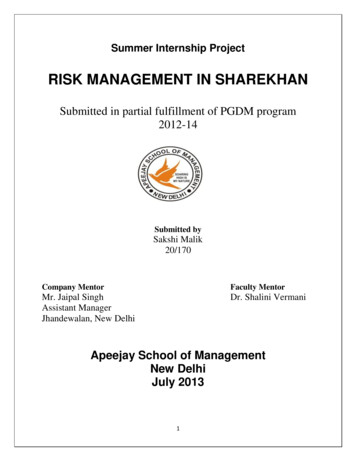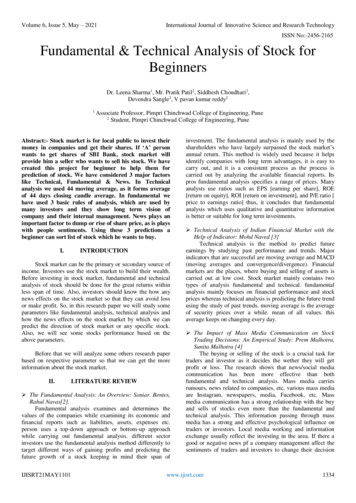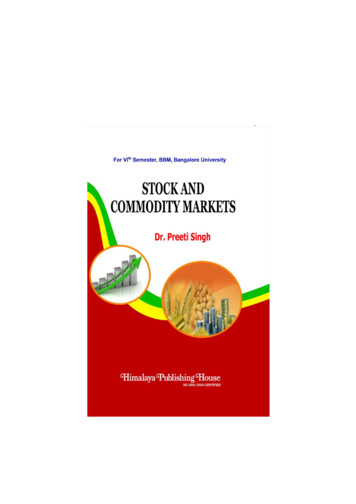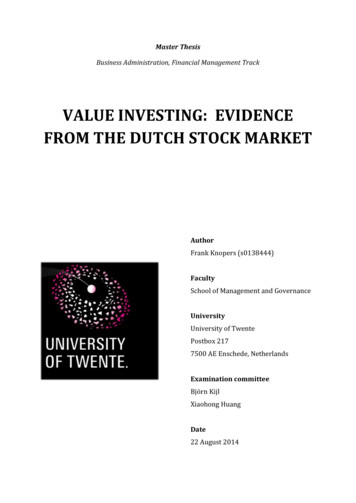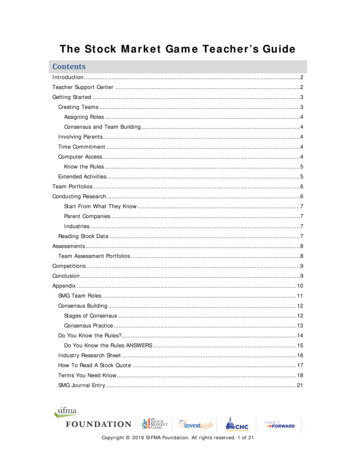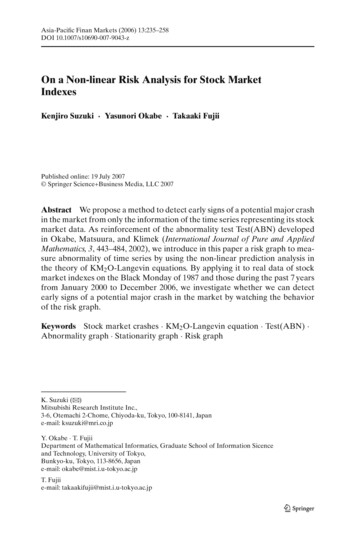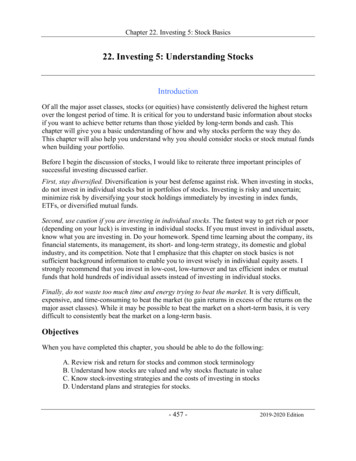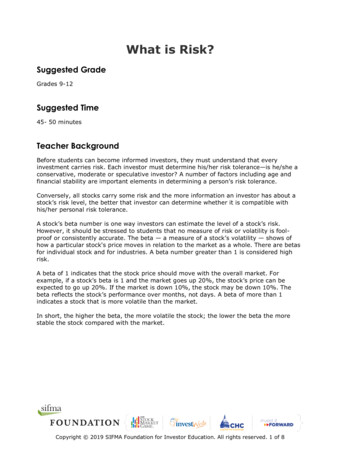
Transcription
What is Risk?Suggested GradeGrades 9-12Suggested Time45- 50 minutesTeacher BackgroundBefore students can become informed investors, they must understand that everyinvestment carries risk. Each investor must determine his/her risk tolerance—is he/she aconservative, moderate or speculative investor? A number of factors including age andfinancial stability are important elements in determining a person’s risk tolerance.Conversely, all stocks carry some risk and the more information an investor has about astock’s risk level, the better that investor can determine whether it is compatible withhis/her personal risk tolerance.A stock’s beta number is one way investors can estimate the level of a stock’s risk.However, it should be stressed to students that no measure of risk or volatility is foolproof or consistently accurate. The beta — a measure of a stock’s volatility — shows ofhow a particular stock's price moves in relation to the market as a whole. There are betasfor individual stock and for industries. A beta number greater than 1 is considered highrisk.A beta of 1 indicates that the stock price should move with the overall market. Forexample, if a stock’s beta is 1 and the market goes up 20%, the stock’s price can beexpected to go up 20%. If the market is down 10%, the stock may be down 10%. Thebeta reflects the stock’s performance over months, not days. A beta of more than 1indicates a stock that is more volatile than the market.In short, the higher the beta, the more volatile the stock; the lower the beta the morestable the stock compared with the market.Copyright 2019 SIFMA Foundation for Investor Education. All rights reserved. 1 of 8
VocabularyBeta Number: A calculation that helps measure the level of risk in investing in a stock.Price/Earnings Ratio (also P/E Ratio): The ratio of the stock’s price per share to itsearnings per share.Risk: The chance of losing all or part of the value of an investment. Risk can be dividedinto three categories:Conservative — fixed income and preferred stocks are considered conservative.Moderate — include growth stocks—particularly young companies with great potential.Speculative — stocks that are highly unpredictable. For example, many dot/com stocksare highly speculative, with incredible highs and devastating lows.Risk Tolerance: An investor’s ability to accept loss of some or all of the money he or shehas invested, based on a number of factors including age, financial stability, amount oftime before the invested funds are needed for other purposes, etc.Volatile/Volatility: The potential unpredictability or instability of a stock. A volatilestock is a risky stock—one that can go very high, or very low.Performance ObjectivesStudents will be able to: Define and illustrate the three major kinds of risk.Examine companies and determine the risk involved in investing in thesecompanies.Research two companies and decide the level of risk their Stock Market Game teamwould take if they invest in these companies.Write a persuasive letter motivating or discouraging an investor from purchasingstocks in a company they researched.Solve decimal multiplication SheetSheetSheetSheet1:2:3:4:Conservative, Moderate or Speculative?To Risk or Not to RiskResearch GuidelinesUnderstanding the Beta NumberCopyright 2019 SIFMA Foundation for Investor Education. All rights reserved. 2 of 8
Springboard ActivityShare this story with your students:When learning about saving and investing, it’s common to hear the phrase, “have yourmoney work for you.” Jamie recently received some money on her birthday. She wantedadvice about the best way to have her money work for her. What’s the best way for hermoney to make more money?Her sister told her, “Buy a lottery ticket. It may be a longshot, but you don’t have tospend much and you could become a millionaire”.Her grandmother said, “Hide it in a safe place in the house so you’ll always have it onhand for emergencies.”Her father advised her, “Buy stock in a technology company. Silicon Valley companies arealways in the news”.Her mother said “Put it in a savings account. It’ll earn compound interest over time, soyou’ll have more than what you started with.”Ask your students:1. Who gave the best advice? Why?2. Who gave the riskiest advice? Why?Discuss students’ responses and then have students propose a definition of “risk” as itrelates to saving and investing.Note: according to Random House College Dictionary, Risk is “exposure to the chance ofinjury or loss.”ProcedureAsk your students:What does Jamie need to learn about investing to make the best decision?Share the following terms with your students:Low risk low returnHigh risk high return, low return or lossAsk your students to define characteristics of a Low Risk investment and those of a HighRisk investment.Their responses should touch on how low risk investments are “safer” and investors worryless about losing their investment. High risk investments are the opposite. Elicit fromCopyright 2019 SIFMA Foundation for Investor Education. All rights reserved. 3 of 8
students the correlation that low risk usually means low profit; high risk may mean highprofit or big losses.Share these terms with your students:Conservative Risk (Low): Means taking limited risk on secure stocks and fixed incomeinvestments. Fixed Income stocks are generally low stocks that pay higher than averagedividends (4% or higher). A dividend is money paid out to the owner of a stock based onthe profit of a company. The value or price of the stock does not change quickly.Moderate Risk: Growth stocks—stocks that grow faster and higher (value and price)than stocks of other companies with similar sales and earnings—are considered to be ofmoderate risk.Speculative Risk (High): Stocks that carry major risks on investments withunpredictable results, but the potential to earn very high returns. When investing inspeculative stocks, the investor must realize that while there is a chance of great returns,there is also the possibility for great loss.Divide the class into their Stock Market Game teams. Have each group rate differentinvestments on Activity Sheet 1: Conservative, Moderate or Speculative? Have studentsshare their answers with the class and explain the reasons for their ratings.Explain that risk is very personal and is based on a variety of elements including: income,age, and financial goals. Different investors can tolerate different levels of risk.Have each SMG team member evaluate risk taken by each individual on Activity Sheet 2:To Risk or Not to Risk? After each team member has evaluated the scenarios on theactivity sheet, have team members discuss their evaluations, reach agreement and sharethe team’s decisions with the class.Explain that risk is very personal and is based on a variety of elements including: income,age, and financial goals. Different investors can tolerate different levels of risk.Have each SMG team member evaluate risk taken by each individual on Activity Sheet 2:To Risk or Not to Risk? After each team member has evaluated the scenarios on theactivity sheet, have team members discuss their evaluations, reach agreement and sharethe team’s decisions with the class.Then have each team lower the investment risk for one (or two) individuals from theactivity sheet who have high-risk investments by writing a new investment plan that haslower risk.AssessmentHave each SMG team, or have students on their own, write a paragraph explaining whattype of investors (low, moderate or high risk) they will try to become in real life and why.Will they be high risk takers? Will they choose growth stocks? Why or why not?Copyright 2019 SIFMA Foundation for Investor Education. All rights reserved. 4 of 8
Have students, alone or in teams, research three stocks: one conservative risk, onemoderate risk, and one speculative risk. They should also calculate the Beta number foreach.Ask your students, if knowing a stock’s Beta number would change how they felt aboutinvesting in it? Why?ApplicationAll SMG teams have been given a virtual 100,000 to invest in the stock market.Ask your students:1. Given what you know about your own risk tolerance level, how will risk influenceyour stock picks?2. Given what you now know about your teammates’ views of risk, might there beconflict in your group over selection of investments? Explain.3. How do you think your tolerance for risk might influence your investment strategyif you had a real 5000 to invest as opposed to a hypothetical 100,000?It is important that students understand they should research many different aspects of acompany to determine if investing in it is worth the risk.Ask your students: “If you are going to invest in a company, how can you evaluate therisk level for that investment?”List ideas.Answers should mention:1.2.3.4.Growth over past months, yearsThe overall economy’s effect on the company’s products or servicesThe company’s new products, mergers, plans for the futureBeta NumbersWorking in SMG teams, have students research two companies in the same industry.Activity Sheet 3: Research Guidelines will direct their research.The students can find all the answers to the activity sheet questions on www.nyse.com orthe company’s website. If students use www.nyse.com, they should click on search andtype in corporation’s name.If students use the company’s website (there is a link from the NYSE website) it hasinformation for investors and media. For example, at the bottom of www.mattel.com,click “investors and media” for all information about the stock and products.Copyright 2019 SIFMA Foundation for Investor Education. All rights reserved. 5 of 8
Enrichment ActivitiesHave students write a business letter to a potential investor encouraging her to purchaseshares in a particular company. This company can be is high risk, with great potential forsuccess or low risk, providing a more modest, but a steady income.Student teams plan a comparative presentation based on the two companies they haveresearched. In this presentation they should note the positive and negative aspects ofboth companies and explain which company may be the most beneficial to invest in andwhy. They should discuss risk factors of investing in each company.Have SMG teams complete Activity Sheet 4: Understanding the Beta Number.Have teams develop a sales pitch to convince an investor to buy stock in one companyand not another, based on the companies’ risks.*Work CitedMladjenovic, Paul. (2002) Stock Investing for Dummies. Indiana: Wiley Publishing, Inc.Answer KeyActivity Sheet 1: Conservative, Moderate or Speculative?Investment 1: This is a moderate risk stock because it is growing at a faster rate thanother clockInvestment 2: This is a conservative stock because it pays a regular dividend as a fixed income stock.Investment 3: This is a speculative stock because there are not guarantees that the drug willwork but it has the potential for high returns.Investment 4: This is still a speculative stock because the car hasn’t been built yet but hasthe potential if it does work and can compete with gasoline fueled automobiles.Investment 5: This is a growth stock because its price is going up very fast. It is a knowcommodity for which there is demand now.Activity Sheet 2: To Risk or Not to Risk?1. Teddy’s risk tolerance is H .2. Juanita’s risk tolerance is M .3. Bill is 62. Bill’s risk tolerance is L .4. Tasha’s risk tolerance is H .5. Their risk tolerance is M .Copyright 2019 SIFMA Foundation for Investor Education. All rights reserved. 6 of 8
6. Devon’ risk tolerance is H .7. Blair’s risk tolerance is M .8. Sam’s risk tolerance is L .9. Lisa’s risk tolerance is H .10.Henry’s risk tolerance is L .Activity Sheet 3: Research GuidelinesAnswers may varyCompanies Researched: Toyota & Target1. What is the 52-week hi and low?Company 1: 1.24/74.79Company 2: 59.77/44.702. What is the P/E Ratio?Company 1:This is not available at the NYSE siteCompany 2:16.323. What is the current price of the stock?Company 1: 101.76Company 2: 46.154. Company 1 Toyota Motor Corporation primarily conducts business in the automotiveindustry. Toyota also conducts business in the finance and other industries. Its businesssegments are automotive operations, financial services operations and all otheroperations. Its automotive operations include the design, manufacture, assembly and saleof passenger cars, recreational and sport utility vehicles, minivans and trucks and relatedparts and accessories. Toyota's financial services business consists primarily of providingfinancing to dealers and their customers for the purchase or lease of Toyota vehicles. Itsfinancial services also provide retail leasing through the purchase of lease contractsoriginated by Toyota dealers Toyota's other operations business segment includes thedesign and manufacture of prefabricated housing and information technology-relatedbusinesses, including certain intelligent transport systems and an e-commercemarketplace called Gazoo.com.Company 2: Target Corporation (Target) operates large-format general merchandisediscount stores in the United States, which include Target and SuperTarget stores. As ofJanuary 28, 2006, the Company owned 1,166 stores, leased 77 stores, and operated 154combined stores for a total of 1,397 locations. As of January 28, 2006, Target's total retailarea was 178,260,000 square feet, with 150,318,000 square feet under Target generalmerchandise stores and 27,942,000 under SuperTarget stores. Target offers anassortment of general merchandise and a more limited assortment of food items in itsstores. SuperTarget stores offer a line of food items along with general merchandise. TheCompany's credit card operation represents an integral component of its core retailCopyright 2019 SIFMA Foundation for Investor Education. All rights reserved. 7 of 8
business. It offers credit to qualified guests through its REDcard products, including theTarget Visa and Target Card. The Company also operates Target.com, an online business.5. Company 1: newer and better alternative fueled vehicles.Company 2: opening many 29 new stores around the country.6. Company 1: The higher the price of gas, the more popular the alternative fuel vehicleswill be.Company2: The higher the price of gas, the more people will want to shop at stores withgreat values.7. Company 1: Moderate because this company is a growth stock because it is investing inmany areas and developing new products, but there is the risk of competition form othercompanies.Company 2: Moderate because this company is a growth stock because it is opening upmany new stores but there is competition with others like Wal-Mart.8. Company 1: Yes I would invest here, because of the potential for suture growth. Theyare investing in new types of cars as well as new products.Company 2: This company is a bit more risky because they are opening so many newstores and have a lot of competition. Still they have good advertising.Activity Sheet 4Part 1: For the following problems, calculate the assumed increase or decrease per share.CompanyComputerWeekInter FinderTeaCompanyCoffeeCompanyBetaNumber1.06S&P 500 YTD%Change-5%Cost per Share83.00Increase/Decrease-4.402.8.32 5%-4%342.0035.0047.88-.451.1 4%37.001.63Part 2: Answers may vary.Copyright 2019 SIFMA Foundation for Investor Education. All rights reserved. 8 of 8
Activity Sheet 1: Conservative, Moderate orSpeculative?Decide if the following investments are conservative, moderate or speculative risks.Investment 1Company Clockwork makes clocks. Compared with other clock making companies,Company Clock has the highest revenue and earnings, but low profits. Company Clock’searnings have grown 15 percent over the past 5 years. The average earnings of other clockcompanies, in the past five years, have been at 10 percent. Based on this scenario, if youinvested in Company Clock, what type of risk are you taking? Explain.Investment 2Jax Company provides gas and electric to your area. The stock pays an annual dividend of 4 per share per year. You own 200 shares, so the company pays you a yearly dividend of 800. This is a fixed income stock. What type of risk are you taking by investing in JaxCompany? ExplainCopyright 2019 SIFMA Foundation for Investor Education. All rights reserved. 1 of 2
Investment 3Watching the news, you learn about a new drug that supposedly makes children smarter.You’ve never heard of the drug manufacturer, but you decide to invest in this company.Why wouldn’t we want our children smarter? If you have no other information and plan toinvest in this drug company, what kind of risk are you taking? Explain.Investment 4Interior Electric announces it is creating an all-electric car, but it hasn’t come out yet. Basedon the news, its stock price has increased 20% in one month. If you buy the stock now,what type of risk are you taking? Explain.Investment 5ALLON oil company’s profits have almost doubled this year. The price of the stock has goneup from 48 to 56 over the same period. If you were to invest in this stock, what degree ofrisk would this investment present? Explain.Copyright 2019 SIFMA Foundation for Investor Education. All rights reserved. 2 of 2
Activity Sheet 2: To Risk or Not to Risk?As we’ve learned, risk tolerance is personal. Based on factors such as age, salary, financialobligations, and family situation, people’s risk tolerances vary greatly. Below aredescriptions of individuals who are thinking about investing in the Stock Market. What doyou think is the risk tolerance of each one? L low; M moderate; H high1. Teddy is 26 and has just gotten a new job at a much higher salary. He is single, has noloans and will get a raise within six months. He wants to invest some of his new-foundwealth. His risk tolerance is .2. Juanita is a single mother with two children, ages 10 and 12. She wants them to go tocollege and is putting aside money to help pay for their educations. It will be six yearsbefore she needs money to help her first child with college. Her risk tolerance is.3. Bill is 62. His health is good. His wife has a low paying job, but their children are grownand off on their own. Bill and his wife will retire in three years. Bill’s risk toleranceis .4. Tasha is 8. Her mother and dad want to start a small investment portfolio for her to usefor college or to help buy a home someday. Tasha’s risk tolerance is .5. Monique and Harrison are in their forties and have three children. They have amortgage and some credit card bills, but they have put aside a small amount of moneyto invest for retirement. They hope to retire when they are 65. Their risk tolerance is.6. Devon is also in his forties. He has paid for his home, makes a good salary and has nochildren. He has a good job and wants to invest money so he can buy a condo at thebeach in 10 years. His risk tolerance is .7. Blair is 20. She is almost finished college. Her parents have paid all of her college costsand have promised to buy a small house for her when she graduates and starts her firstjob. Blair works on the weekends and during the summer; she has saved severalhundred dollars, which she wants to invest. Blair’s risk tolerance is .8. Sam works in a fast-food restaurant as a cook. He barely makes enough money to paythe rent and buy groceries for his wife and baby. Sam is 35. His grandmother died andleft him 2,000, which Sam wants to invest. Sam’s risk tolerance is .9. Lisa is 27 and has a good job and few bills. She wants to invest so that in five years shecan take a year off to travel in Europe. She has 5,000 to invest and will need 25,000to take the trip of her dreams. Her risk tolerance is .10. Henry is 68 and retired. The company he retired from recently dissolved its pensionfund and sent him a check for 20,000. Henry is very healthy and expects to live atleast another 20 years. He gets Social Security and has a small amount of savings.Henry’s risk tolerance is .Copyright 2019 SIFMA Foundation for Investor Education. All rights reserved. 1 of 1
Activity Sheet 3: Research GuidelinesIndividual Completing Research:Companies Researched:Each member of your Stock Market Game team must research two public companies for inpreparation for your team making its stock selections.TIPS: You will find answers to the questions below on www.nyse.com or the companies’websites. On www.nyse.com, click search and type the company’s name. If you go to thecompany website (follow the link from the NYSE website) to find information for investorsand media. For example, at the bottom of www.mattel.com, click on “investors and media”for information about the stock and products.1. What is the 52-week hi and low?Company 1:Company 2:2. What is the P/E Ratio?Company 1:Company 2:3. What is the current price of the stock?Company 1:Company 2:4. Explain what the company is and does?Company 1:Company 2:Copyright 2019 SIFMA Foundation for Investor Education. All rights reserved. 1 of 3
5. Are there any new products the company plans to make public soon?Company 1:Company 2:6. What impact does the condition of the economy have on the products and services ofthis company?Company 1:Company 2:7. What type of risk do you think you are taking when you invest in these companies?Why?Company 1:Copyright 2019 SIFMA Foundation for Investor Education. All rights reserved. 2 of 3
Company 2:8. Based on your research, will you recommend this company to your team for potentialinvestment? Why?Company 1:Company 2:Copyright 2019 SIFMA Foundation for Investor Education. All rights reserved. 3 of 3
Activity Sheet 4: Understanding BetaThe following problems explain how the beta number reflects the movement of a company’sstock compared to the overall market. The S&P 500 Index is composed of 500 majorcompanies; it measures the average increase or decrease over a specific period of time. Abeta of one indicates that the stock's price moves exactly with the overall market. Forexample, if the market goes up 20%, the stock price goes up 20%. Market goes down 10%stock goes down 10%.A stock with a beta of more than one is more volatile than the market. If the market goesup, it tends to go up at a greater magnitude (i.e. market goes up 10%, stock goes up15%). The higher the beta number, the more volatile the stock. A beta of less than oneindicates that the stock's price is more stable than the market.For example, Company A has a beta of .5, the price per share is 50.00 and the S&P moved-4%. To calculate how much the stock may change use the following formula(S&P X Beta Number) X Cost of Share Assumed increase/ decrease per share(-.04 x .5) 50.00 -1.00Whereas a company that has a beta of 2.3, price per share 50.00 and the S&P moved -4%(-.04 x 2.3) 50.00 -4.60Notice the loss is much greater in the second company. If the S&P moved up 4%, the gainwould be much greater.NOTE: This does NOT mean the stock value moved this much on that day. It assumes thestock moved, based on its history and movement within the stock market.Part 1For the following problems, calculate the assumed increase or decrease per share.CompanyBetaNumberCost perShare1.06S&P 500YTD%Change-5%Computer WeekInter Finder2.8 5%342.00Tea Company.32-4%35.00Coffee Company1.1 4%37.00Increase/Decrease83.00Copyright 2019 SIFMA Foundation for Investor Education. All rights reserved. 1 of 2
Part 2Research three companies you would like to invest in. Find the beta number, and decide ifthe risk if worth taking, based on what you know about company. Fill in the following chart.To find the S&P 500 Index use the following ta numbers are usually available in a stock’s price quote.CompanyBetaNumberS&P 500YTD% ChangeCost perShareIncrease/DecreaseWhich company is the least volatile? Most volatile?Would you invest in the company that is the most volatile? Why or why not?Copyright 2019 SIFMA Foundation for Investor Education. All rights reserved. 2 of 2
Stock Investing for Dummies. Indiana: Wiley Publishing, Inc. Answer Key Activity Sheet 1: Conservative, Moderate or Speculative? Investment 1: This is a moderate risk stock because it is growing at a faster rate than other clock . Investment 2: This is a conservative stock because it pays a regular dividend as a fixed income stock.
